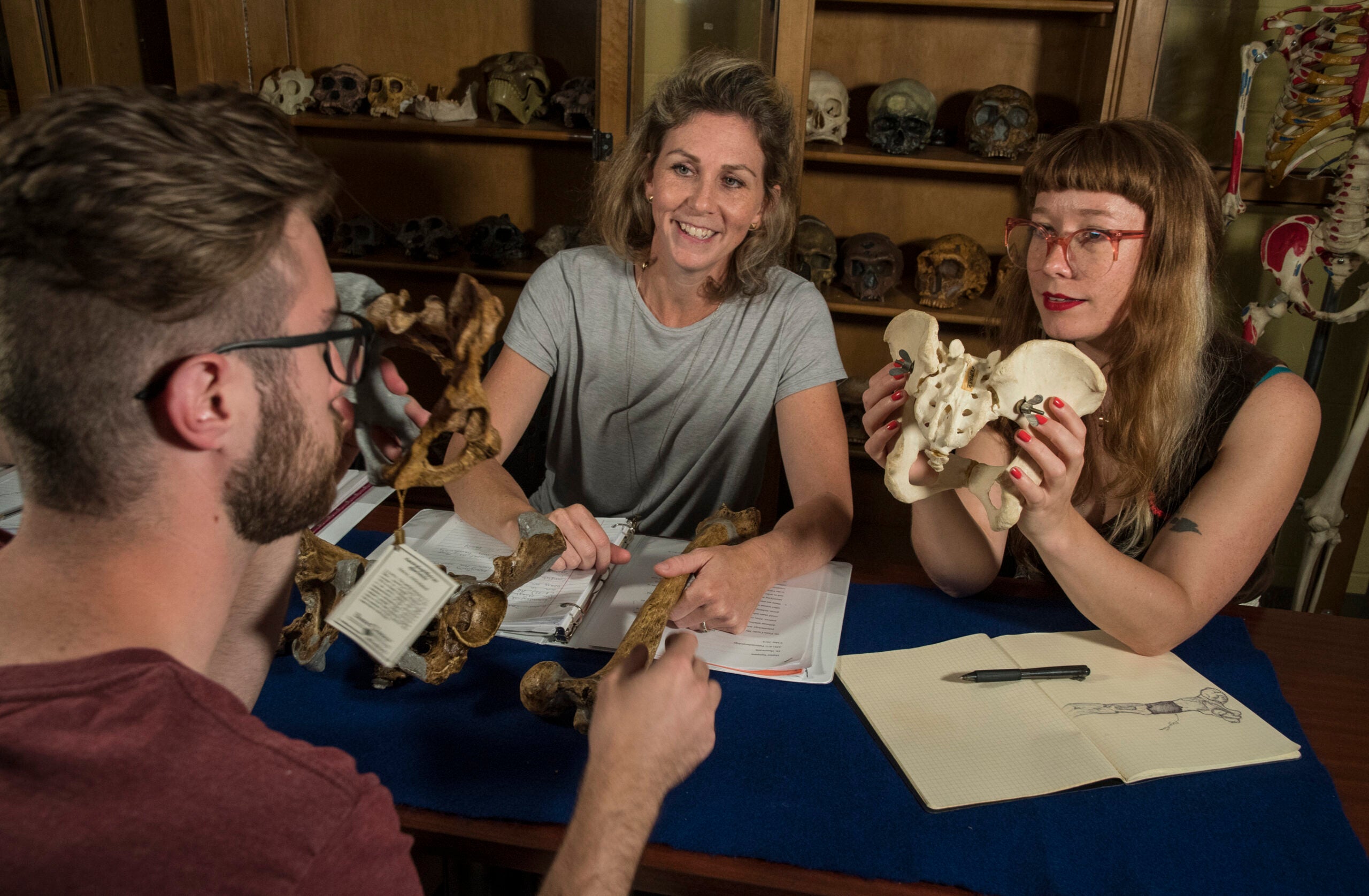KINGSTON, R.I. – Feb. 5, 2020 – Why hasn’t human evolution solved painful childbirth?
In evolving from other early primates, two distinctly human features – big brains and walking upright – have led to difficult childbirth. As the evolutionary tale goes: as we progressed to walk upright, the human pelvis became narrower and the birth canal more complex than other primates. Our chimp and gorilla cousins – with smaller-brained babies and wider pelvises – have relatively shorter and seeming less painful births. But humans struggle.
So why didn’t human anatomy evolve to fix the problem?
“Why didn’t we evolve away from painful bowel movements? Why didn’t we evolve out of painful breakups?” asks University of Rhode Island anthropologist Holly Dunsworth in “Childbirth,” the closing episode of the Netflix documentary series “Sex, Explained.” “What works works and what is good enough is good enough. It’s a terribly tight fit, it’s a painful labor, it’s a long, protracted labor, but it works. It’s good enough.”
Dunsworth, an associate professor in the URI Department of Sociology and Anthropology, is among a half-dozen experts who lend their knowledge and childbirth experiences to “Childbirth,” which was released in January and is available on YouTube, along with Netflix. “Sex, Explained” is a spinoff of the short-documentary series “Explained,” produced by Vox Media.
Dunsworth is a prolific writer and tweeter who has appeared widely in the news, discussing such research as the evolution of childbirth and gestation; why babies cry; why chimps can’t throw well; and the fact humans may be the only species that understands that sex makes babies. She also is not shy about snapping off an ear-catching turn-of-phrase.
That’s why producers of “Childbirth” contacted her. “They said, ‘We’re reading your stuff and so many things you write about are what we want to talk about,’” she says. “They were also reading my personal blog about my childbirth experience – where I argued it was natural even though it was a Caesarean section.”
More than willing to challenge accepted evolutionary narratives, Dunsworth has studied the evolution of childbirth and has done just that. Her work has helped dispute the long-held theory of “obstetric dilemma,” which links the duration of human gestation to the baby’s big brain and the mother’s narrow birth canal. As the theory goes, babies are born before their heads grow too big, resulting in infants seemingly underdeveloped compared with other newborn primates.
Dunsworth has found many problems with “obstetric dilemma,” and helped develop a theory to better explain the duration of gestation. Working with Peter Ellison of Harvard and Herman Pontzer of Duke University, they developed a hypothesis for timing human birth to metabolism. It posits that babies are born when the mother cannot put any more energy into gestation and fetal growth – going into labor as she is about to cross into a metabolic danger zone.
Even for early humans 3 million years ago, childbirth wasn’t a piece of cake. “We have evidence that we think it became more difficult than it is for current chimpanzees and gorillas by the time Lucy was walking around with her barely bigger-than-chimp-size brain,” Dunsworth says.
It has only gotten harder over millions of years. But one reason is a mystery, she says. While the pelvis narrowed as we walked upright over millennia, no evidence shows that a wider pelvis would impede walking efficiency. So, is there a good reason?
“Well, it could be that’s the best way to hold up our guts and everything else,” she says. “But we haven’t worked that out. Engineers and anthropologists and anatomists really haven’t come up with a really good way of knowing whether this, right now, is how big the pelvis can get.”
There are other factors that contribute to painful childbirth. Modern living – including diet and malnutrition, inactivity during development – affect how the birth canal develops. Also, the globalization of love could play a part. “Normally within populations males and females differ in body size in a similar fashion,” she says. “But there are small bodied populations and then there are tall populations. Small women who reproduce with tall men are having difficult childbirth.”
A large part of the “Childbirth” documentary is the cultural response around pain and birth – including interventions such as drugs to induce labor and reduce pain, and C-sections. Dunsworth, a mother of a 5-year-old, tells her own childbirth story in the episode and how she is still conflicted about the medical interventions she faced.
“When the filmmakers asked me about my personal childbirth experience, suddenly I wasn’t prepared, even though I had written about it publicly,” she says. “It’s easy for me to talk about the science. I do that all the time. But while the cameras were rolling I had to on the fly decide ‘how much of my personal story do I want to give to Netflix?’ But I knew immediately when I started talking to them that they were doing a really well-researched, quality show. So, I trusted them because I respected them.”
One of the big questions that remains about childbirth and the pain, says Dunsworth, is “how can we cut the rate of unnecessary interventions and still have these wonderful birth outcomes?”
“There are women who will always want a C-section or want drugs to ease the pain, but there are a lot of women who would really love to see what the human body is capable of,” she says. “How can we change culture to give nature back? Can we figure out how to re-create nature in a safe way.”

